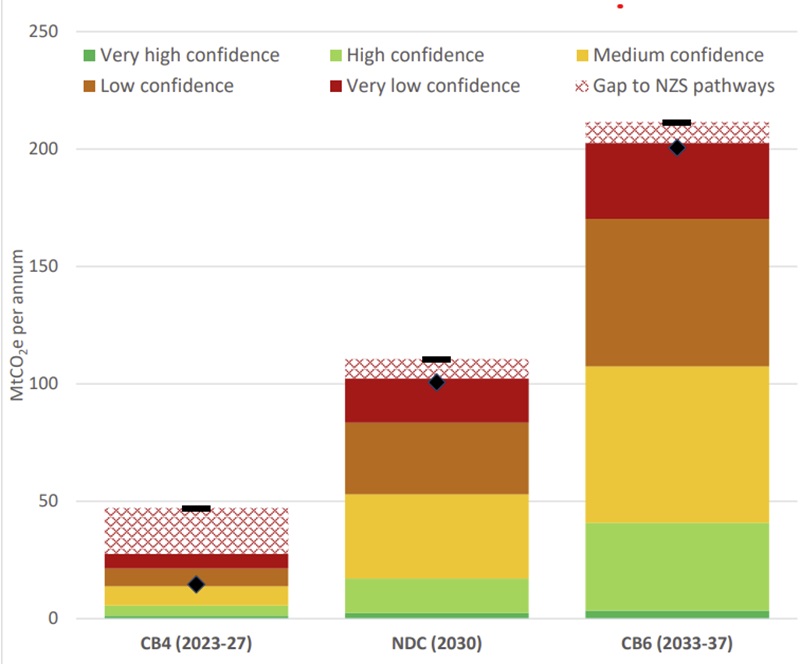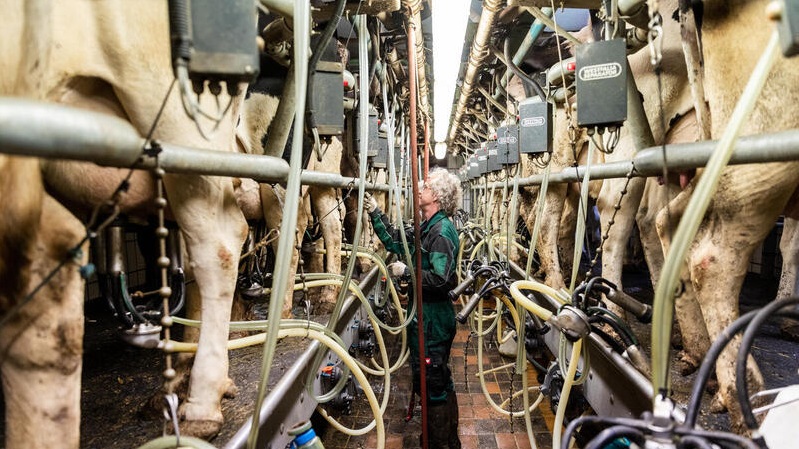British civil servants have grave doubts about their government’s favoured techno-fixes for climate-polluting industries like meat production and air travel, new documents show.
In risk assessments made public because of an ongoing court case, officials warned that technology to reduce methane emissions from cow burps is “nascent” and there might not be enough plants or hydrogen available to power the world’s planes more sustainably.
Yet despite the uncertainties surrounding these and other climate solutions like carbon dioxide removal, the UK government is relying on such technologies to meet a big chunk of its climate plans.
Internal government documents disclosed in court show civil servants had “low” or “very low” confidence in about half of the planned emissions reductions up to 2037 and “very high confidence” in just a tiny fraction.

UK civil servants rated about half their planned emission cuts as “low” or “very low” confidence
In court, the government’s lawyer said that these categories should not be taken out of context – and that certain measures could be rated “very low confidence” just because it is “early days”.
The risk analysis was put together by unnamed civil servants at the UK’s Department for Energy Security and Net Zero in 2022 and was supposed to help shape the government’s latest carbon budget delivery plan, aimed at keeping the country on track for net-zero emissions by mid-century.
The plan was published in March 2023 along with a sanitised version of the risks and uncertainties that civil servants foresaw in meeting it.
But the full risk tables were made public this week as environmental campaigners took the government to court, arguing that civil servants did not give then climate minister Grant Shapps enough information to judge whether the UK’s climate plan was sufficient.
The Department for Energy Security and Net Zero did not immediately respond to a request for comment.
https://twitter.com/goodlawproject/status/1760210497800962252?s=46&t=1evSGSBoh-eT20bb9Nq91g
Katie de Kauwe, a lawyer for Friends of the Earth, one of the groups bringing the case, said the analysis shows “much of the government’s ‘strategy’ to meet legally-binding climate targets amounts to wishful thinking”.
ClientEarth lawyer Sam Hunter Jones, said: “These risk tables only further prove that the government is choosing to look the other way when it comes to the clear possibility of its climate plans failing.”
Where’s the green fuel?
The government has said it plans to cut 611 million tonnes of carbon dioxide (CO2) emissions from 2023 to 2037 from international aviation and shipping – about an eighth of its total emissions reductions over those 15 years.
Plans to decarbonise aviation currently rest largely on sustainable aviation fuel (SAF), made from plant material called biomass.
Countries draw battle lines for talks on new climate finance goal
But the civil servants privately warned there may not be enough of this biomass required to power the planes.
“Feedstock availability is a key dependency to supply necessary quantities of SAF,” the risk assessment says, adding “increased global demand for biomass could impact the deliverability of these project savings”.
“Zero emission flight technology is at an early stage of development and delivery of this ambition will be challenging,” it notes.
Planes could also – at least in theory – be powered with hydrogen but this may also be in short supply.
The civil servants say “the availability of low carbon hydrogen at scale from 2030 onwards is likely to be critical”.
The government’s plan does not mention strategies to reduce flight numbers or encourage people to travel by train.
Cow super-foods
The carbon budget delivery plan also estimates that the damage done by livestock, particularly cows, burping the potent greenhouse gas methane can be reduced by 4 million tonnes between 2023 and 2037 by giving them special food and not feeding them too much.
But the previously unpublished analysis warns that the emissions savings from this are “uncertain” as the technology is “nascent”. The plan does not include measures to reduce the numbers of ruminants like cows or to promote a move away from meat-based diets.
The most recent summary of climate science from the Intergovernmental Panel on Climate Change found that technologies that ease pollution from livestock flatulence based on seaweed or algae are “promising” but there are doubts about the environmental side-effects and whether the emissions cuts from using them will be lasting.
The UK government’s plan also relies on technologies that suck carbon dioxide from the atmosphere to contribute 30 million tonnes of CO2 reduction between 2023 and 2037.
Despite Cop28 pledge, France keeps fossil fuel subsidies for farmers
But the civil servants say they are “uncertain” this will be delivered. This is partly because “greenhouse removals technologies have never been deployed at scale, creating inherent uncertainties and risk”, and “additional research and innovation” is required.
These technologies vary but include burning plant material or hydrogen for electricity and capturing the carbon emitted, as well as sucking CO2 out of the atmosphere with direct air capture machines.
In addition, the officials flag concerns about using hydrogen – a gas that doesn’t damage the atmosphere when burned and can be made with carbon-free electricity – to heat homes as an emissions-cutting bet.
“The use of hydrogen for heat is not yet a fully established technology,” they say, adding “there is uncertainty on the carbon savings associated with hydrogen heating policy”.
They do not raise doubts about heat pump technology except with regard to cost and how to heat buildings where pumps are not suitable.
Climate finance fail
Despite cuts to the UK’s development aid budget since the COVID-19 pandemic, the UK government has insisted it will deliver on a much-hyped promise to deliver £11.6 billion ($14.7 bn) in climate finance to developing countries between 2021 and 2026. But in the newly released documents, civil servants warn of “material risks” to meeting that commitment.
They blame this on the UK cutting its annual aid spending from 0.7% of gross national income to 0.5%, and the redeployment of almost a third of the aid budget to cover the cost of hosting Ukrainian refugees.
This supports the claim made by former environment minister Zac Goldsmith, who resigned in June saying the government had “effectively abandoned” the climate finance pledge, which was “one of the most widely reported and solemn promises we have made on this issue”.
The Guardian newspaper also last year published a leaked government document warning the UK would find it a “huge challenge” to respect the pledge. At that time, the foreign and development ministry said “claims that the international climate finance pledge is being dropped are false”.
Emma Dearnaley, legal director of the Good Law Project, asked: “How can the UK credibly claim to be a world leader in tackling climate change when it is falling behind on its legal commitments to help those who will bear the brunt of it?”
Developing countries have been angered by news on the expected shortfall in Britain’s climate funding. Last June, an African negotiator told Climate Home it was “disappointing”, while Bolivia’s Diego Pacheco said the UK would not be respecting the United Nations climate change convention or the Paris Agreement.
The court hearing finished today, but it is likely to be months before the judge returns a verdict.
